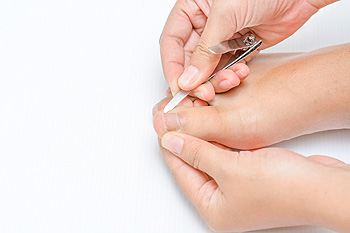Items filtered by date: March 2023
Morton’s Neuroma and Insoles

Morton’s neuroma is one of many various foot conditions that can negatively impact the health of the feet. When a patient has Morton’s neuroma, this typically means that the tissue surrounding a nerve in the foot leading to the toes has become thick. As a result of this thickening, patients can feel pain and they might feel sensations as if there was a pebble in their shoe. There are several different steps that an individual might consider taking to address Morton’s neuroma. In consultation with a health professional, such as a podiatrist, an individual might decide to treat Morton’s neuroma by using devices such as insoles. The use of these insoles can essentially absorb shock when walking, it can also provide support for the arch, and it can correct alignment issues. All of these adjustments can relieve the pain felt by Morton’s neuroma. If you are someone that is living with Morton’s neuroma, it is suggested that you schedule an appointment with a podiatrist today.
Morton’s neuroma is a very uncomfortable condition to live with. If you think you have Morton’s neuroma, contact one of our podiatrists of Houston Foot and Ankle Care. Our doctors will attend to all of your foot care needs and answer any of your related questions.
Morton’s Neuroma
Morton's neuroma is a painful foot condition that commonly affects the areas between the second and third or third and fourth toe, although other areas of the foot are also susceptible. Morton’s neuroma is caused by an inflamed nerve in the foot that is being squeezed and aggravated by surrounding bones.
What Increases the Chances of Having Morton’s Neuroma?
- Ill-fitting high heels or shoes that add pressure to the toe or foot
- Jogging, running or any sport that involves constant impact to the foot
- Flat feet, bunions, and any other foot deformities
Morton’s neuroma is a very treatable condition. Orthotics and shoe inserts can often be used to alleviate the pain on the forefront of the feet. In more severe cases, corticosteroids can also be prescribed. In order to figure out the best treatment for your neuroma, it’s recommended to seek the care of a podiatrist who can diagnose your condition and provide different treatment options.
If you have any questions, please feel free to contact our offices located in Inner Loop, Southwest, Greater Heights, and Pearland, TX . We offer the newest diagnostic and treatment technologies for all your foot care needs.
Are You Suffering From Ingrown Toenails?
Ingrown Toenails and Pus

An ingrown toenail can develop when the side of the nail essentially grows into the skin surrounding the toenail. Not only can this condition be unsightly, it can also cause a patient discomfort and pain. Ingrown toenails have an interesting relationship to pus that patients ought to be familiar with. Pus can sometimes ooze from an ingrown toenail if there is an infection. In these circumstances, the pus may appear to be a green or yellow color. Pus can therefore be a helpful indicator that something might be wrong with your ingrown toenail. Infections are nothing to take lightly, and if you believe you have one, seek out medical attention. If you are someone that struggles with a case of ingrown toenails, it is suggested that you contact a podiatrist today for treatment and advice.
Ingrown toenails can become painful if they are not treated properly. For more information about ingrown toenails, contact one of our podiatrists of Houston Foot and Ankle Care. Our doctors can provide the care you need to keep you pain-free and on your feet.
Ingrown Toenails
Ingrown toenails occur when a toenail grows sideways into the bed of the nail, causing pain, swelling, and possibly infection.
Causes
- Bacterial infections
- Improper nail cutting such as cutting it too short or not straight across
- Trauma to the toe, such as stubbing, which causes the nail to grow back irregularly
- Ill-fitting shoes that bunch the toes too close together
- Genetic predisposition
Prevention
Because ingrown toenails are not something found outside of shoe-wearing cultures, going barefoot as often as possible will decrease the likeliness of developing ingrown toenails. Wearing proper fitting shoes and using proper cutting techniques will also help decrease your risk of developing ingrown toenails.
Treatment
Ingrown toenails are a very treatable foot condition. In minor cases, soaking the affected area in salt or antibacterial soaps will not only help with the ingrown nail itself, but also help prevent any infections from occurring. In more severe cases, surgery is an option. In either case, speaking to your podiatrist about this condition will help you get a better understanding of specific treatment options that are right for you.
If you have any questions please feel free to contact our offices located in Inner Loop, Southwest, Greater Heights, and Pearland, TX . We offer the newest diagnostic and treatment technologies for all your foot and ankle needs.
Standing For Too Long

If you are someone whose employment causes you to stand on your feet for long periods of the workday, you might be putting yourself at an increased risk of developing a foot condition. For example, it is suggested that an individual stands for approximately two to four hours each day. When an individual must stand for too long every single day, they could be putting too much strain on their feet. Employees like hairdressers, cashiers, and factory line workers could all be spending too much of the day standing on their feet. To address this issue, an employee might consider breaking up the workday by taking sitting breaks to ensure that they are not standing for the entire day. If you are a worker that spends a lot of the work day standing, it is highly suggested that you contact a podiatrist today.
While working on the feet, it is important to take the proper care of them. For more information about working on your feet, contact one of our podiatrists from Houston Foot and Ankle Care. Our doctors will treat your foot and ankle needs.
Working on Your Feet
Standing on your feet for long periods of time can cause stress and pain in your feet. Your whole body may experience change in terms of posture, back pain, bunions, callouses and or plantar warts. There are ways to avoid these conditions with proper foot care, smart choices and correct posture.
Positive Changes
Negative heeled shoe – Choosing this shoe type places the heel slightly lower than the ball of the foot. These are great for overall foot health. Find shoes that fit you correctly.
Go barefoot – Our feet were not designed to be enclosed for all hours of the day. Try to periodically expose your feet to air.
Eliminate Pain
Foot Exercises – Performing simple exercises, incorporating yoga and doing stretches are beneficial. This will allow increased blood flow to the area and muscles of the foot.
Achilles tendon – Stretching the foot out flat on the floor will relax the calf muscles and tendon. These exercises can be performed almost anywhere. Make sure you add these exercises to your daily regimen.
With a little bit of this information and knowing more about foot health, you will notice changes. Foot stretches and proper footwear will help with pain and prevent further issues.
If you have any questions please feel free to contact our offices located in Inner Loop, Southwest, Greater Heights, and Pearland, TX . We offer the newest diagnostic and treatment technologies for all your foot and ankle needs.
Relief Methods for Sever’s Disease

Heel pain is a common symptom with Sever’s disease. It is a condition that affects children and young teenagers who engage in running and jumping activities, and it can be quite painful. Additionally, wearing shoes with studs may increase the chances of developing Sever’s disease. A growth spurt can cause the bones to grow faster than the surrounding muscles and tendons, and the Achilles tendon is often affected. This tendon connects the heel to the calf muscles and can become sore with existing heel pain. This condition can be properly diagnosed when symptoms and performance levels are noticed, and treatment can begin with temporarily stopping the activity that caused the pain. This is typically followed by performing stretches that can strengthen the affected heel. Mild relief may be found when cushioned heel pads are worn and the leg is frequently elevated, possibly helping to reduce existing swelling. Limping and standing on tip toes may indicate your active child has Sever’s disease, and if applicable, it is suggested that you consult with a podiatrist who can offer relief and treatment techniques.
Sever's disease often occurs in children and teens. If your child is experiencing foot or ankle pain, see one of our podiatrists from Houston Foot and Ankle Care. Our doctors can treat your child’s foot and ankle needs.
Sever’s Disease
Sever’s disease is also known as calcaneal apophysitis, which is a medical condition that causes heel pain I none or both feet. The disease is known to affect children between the ages of 8 and 14.
Sever’s disease occurs when part of the child’s heel known as the growth plate (calcaneal epiphysis) is attached to the Achilles tendon. This area can suffer injury when the muscles and tendons of the growing foot do not keep pace with bone growth. Therefore, the constant pain which one experiences at the back of the heel will make the child unable to put any weight on the heel. The child is then forced to walk on their toes.
Symptoms
Acute pain – Pain associated with Sever’s disease is usually felt in the heel when the child engages in physical activity such as walking, jumping and or running.
Highly active – Children who are very active are among the most susceptible in experiencing Sever’s disease, because of the stress and tension placed on their feet.
If you have any questions, please feel free to contact our offices located in Inner Loop, Southwest, Greater Heights, and Pearland, TX . We offer the newest diagnostic and treatment technologies for all your foot and ankle injuries.


